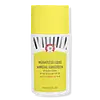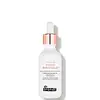What's inside
What's inside
 Key Ingredients
Key Ingredients

 Benefits
Benefits

 Concerns
Concerns

 Ingredients Side-by-side
Ingredients Side-by-side

Zinc Oxide 22%
Cosmetic ColorantEthylhexyl Olivate
Skin ConditioningIsododecane
EmollientCoconut Alkanes
EmollientWater
Skin ConditioningAluminum Starch Octenylsuccinate
AbsorbentCaprylic/Capric Triglyceride
MaskingButylene Glycol
HumectantMica
Cosmetic ColorantPolyglyceryl-6 Polyricinoleate
EmulsifyingJojoba Esters
EmollientCellulose
AbsorbentStearalkonium Hectorite
Gel FormingSodium Chloride
MaskingSqualane
EmollientPolyglyceryl-3 Diisostearate
EmulsifyingPolyglyceryl-3 Polyricinoleate
EmulsifyingIron Oxides
Phenoxyethanol
PreservativeTocopheryl Acetate
AntioxidantCoco-Caprylate/Caprate
EmollientTrihydroxystearin
Skin ConditioningCaprylyl Glycol
EmollientPolyhydroxystearic Acid
EmulsifyingGlycerin
HumectantTrisodium Ethylenediamine Disuccinate
Propanediol
SolventSorbic Acid
PreservativeTitanium Dioxide
Cosmetic ColorantSilica
AbrasiveGlycyrrhiza Glabra Root Extract
BleachingCamellia Sinensis Leaf Extract
AntimicrobialAlumina
AbrasiveTocopherol
AntioxidantChrysanthemum Parthenium Extract
Skin ConditioningZinc Oxide 22%, Ethylhexyl Olivate, Isododecane, Coconut Alkanes, Water, Aluminum Starch Octenylsuccinate, Caprylic/Capric Triglyceride, Butylene Glycol, Mica, Polyglyceryl-6 Polyricinoleate, Jojoba Esters, Cellulose, Stearalkonium Hectorite, Sodium Chloride, Squalane, Polyglyceryl-3 Diisostearate, Polyglyceryl-3 Polyricinoleate, Iron Oxides, Phenoxyethanol, Tocopheryl Acetate, Coco-Caprylate/Caprate, Trihydroxystearin, Caprylyl Glycol, Polyhydroxystearic Acid, Glycerin, Trisodium Ethylenediamine Disuccinate, Propanediol, Sorbic Acid, Titanium Dioxide, Silica, Glycyrrhiza Glabra Root Extract, Camellia Sinensis Leaf Extract, Alumina, Tocopherol, Chrysanthemum Parthenium Extract
Water
Skin ConditioningIsododecane
EmollientPolyglyceryl-6 Polyricinoleate
EmulsifyingPropanediol
SolventDimethicone
EmollientCaprylic/Capric Triglyceride
MaskingTrimethylsiloxysilicate
EmollientButyloctyl Salicylate
Skin ConditioningCoco-Caprylate/Caprate
EmollientIsoamyl Laurate
EmollientNeopentyl Glycol Diheptanoate
EmollientPolyglyceryl-10 Dioleate
EmulsifyingLecithin
EmollientPolyhydroxystearic Acid
EmulsifyingEctoin
Skin ConditioningPolymethylsilsesquioxane
Polysilicone-11
Disteardimonium Hectorite
StabilisingButyrospermum Parkii Butter
Skin ConditioningGlycerin
HumectantPhenoxyethanol
PreservativePropylene Carbonate
SolventAminomethyl Propanol
BufferingCitrus Aurantium Dulcis Peel Oil
MaskingEthylhexylglycerin
Skin ConditioningPolysorbate 20
EmulsifyingSclareolide
MaskingTocopheryl Acetate
AntioxidantDimethicone/Vinyl Dimethicone Crosspolymer
Skin ConditioningDimethiconol
EmollientLinalool
PerfumingLinalyl Acetate
MaskingPlankton Extract
Skin ConditioningLavandula Angustifolia Oil
MaskingLavandula Hybrida Oil
EmollientDecyl Glucoside
CleansingSodium Ascorbate
AntioxidantCaprylyl Glycol
EmollientHexylene Glycol
EmulsifyingTocopherol
AntioxidantWater, Isododecane, Polyglyceryl-6 Polyricinoleate, Propanediol, Dimethicone, Caprylic/Capric Triglyceride, Trimethylsiloxysilicate, Butyloctyl Salicylate, Coco-Caprylate/Caprate, Isoamyl Laurate, Neopentyl Glycol Diheptanoate, Polyglyceryl-10 Dioleate, Lecithin, Polyhydroxystearic Acid, Ectoin, Polymethylsilsesquioxane, Polysilicone-11, Disteardimonium Hectorite, Butyrospermum Parkii Butter, Glycerin, Phenoxyethanol, Propylene Carbonate, Aminomethyl Propanol, Citrus Aurantium Dulcis Peel Oil, Ethylhexylglycerin, Polysorbate 20, Sclareolide, Tocopheryl Acetate, Dimethicone/Vinyl Dimethicone Crosspolymer, Dimethiconol, Linalool, Linalyl Acetate, Plankton Extract, Lavandula Angustifolia Oil, Lavandula Hybrida Oil, Decyl Glucoside, Sodium Ascorbate, Caprylyl Glycol, Hexylene Glycol, Tocopherol
 Reviews
Reviews

Ingredients Explained
These ingredients are found in both products.
Ingredients higher up in an ingredient list are typically present in a larger amount.
This ingredient is an emollient, solvent, and texture enhancer. It is considered a skin-softener by helping the skin prevent moisture loss.
It helps thicken a product's formula and makes it easier to spread by dissolving clumping compounds.
Caprylic Triglyceride is made by combining glycerin with coconut oil, forming a clear liquid.
While there is an assumption Caprylic Triglyceride can clog pores due to it being derived from coconut oil, there is no research supporting this.
Learn more about Caprylic/Capric TriglycerideCaprylyl Glycol is a humectant and emollient, meaning it attracts and preserves moisture.
It is a common ingredient in many products, especially those designed to hydrate skin. The primary benefits are retaining moisture, skin softening, and promoting a healthy skin barrier.
Though Caprylyl Glycol is an alcohol derived from fatty acids, it is not the kind that can dry out skin.
This ingredient is also used as a preservative to extend the life of products. It has slight antimicrobial properties.
Learn more about Caprylyl GlycolCoco-Caprylate/Caprate is created from fatty coconut alcohol, caprylic acid, and capric acid.
It is a lightweight emollient. Emollients create a thin barrier on the skin to trap moisture in. This helps keep your skin hydrated and soft.
Once applied, Coco-Caprylate/Caprate is absorbed quickly and leaves a silky feel.
Coco-Caprylate/Caprate may not be fungal acne safe.
Learn more about Coco-Caprylate/CaprateGlycerin is already naturally found in your skin. It helps moisturize and protect your skin.
A study from 2016 found glycerin to be more effective as a humectant than AHAs and hyaluronic acid.
As a humectant, it helps the skin stay hydrated by pulling moisture to your skin. The low molecular weight of glycerin allows it to pull moisture into the deeper layers of your skin.
Hydrated skin improves your skin barrier; Your skin barrier helps protect against irritants and bacteria.
Glycerin has also been found to have antimicrobial and antiviral properties. Due to these properties, glycerin is often used in wound and burn treatments.
In cosmetics, glycerin is usually derived from plants such as soybean or palm. However, it can also be sourced from animals, such as tallow or animal fat.
This ingredient is organic, colorless, odorless, and non-toxic.
Glycerin is the name for this ingredient in American English. British English uses Glycerol/Glycerine.
Learn more about GlycerinIsododecane is a fragrance, emollient, and solvent.
As an emollient, it helps your skin stay soft and hydrated. Emollients help trap moisture into your skin.
Isododecane's role as a solvent makes it a great texture enhancer. It spreads smoothly on skin and does not leave a sticky feeling behind. Isododecane also helps prevent color transfer in makeup products.
Isododecane is not absorbed into skin.
Learn more about IsododecanePhenoxyethanol is a preservative that has germicide, antimicrobial, and aromatic properties. Studies show that phenoxyethanol can prevent microbial growth. By itself, it has a scent that is similar to that of a rose.
It's often used in formulations along with Caprylyl Glycol to preserve the shelf life of products.
Polyglyceryl-6 Polyricinoleate isn't fungal acne safe.
Polyhydroxystearic Acid is a soft wax made from castor oil.
It is is a texture thickener, emulsifier, and film-former. Emulsifiers prevent ingredients from separating, such as oils and waters.
Polyhydroxystearic Acid may not be fungal acne safe.
Learn more about Polyhydroxystearic AcidPropanediol is an all-star ingredient. It softens, hydrates, and smooths the skin.
It’s often used to:
Propanediol is not likely to cause sensitivity and considered safe to use. It is derived from corn or petroleum with a clear color and no scent.
Learn more about PropanediolTocopherol (also known as Vitamin E) is a common antioxidant used to help protect the skin from free-radicals and strengthen the skin barrier. It's also fat soluble - this means our skin is great at absorbing it.
Vitamin E also helps keep your natural skin lipids healthy. Your lipid skin barrier naturally consists of lipids, ceramides, and fatty acids. Vitamin E offers extra protection for your skin’s lipid barrier, keeping your skin healthy and nourished.
Another benefit is a bit of UV protection. Vitamin E helps reduce the damage caused by UVB rays. (It should not replace your sunscreen). Combining it with Vitamin C can decrease sunburned cells and hyperpigmentation after UV exposure.
You might have noticed Vitamin E + C often paired together. This is because it is great at stabilizing Vitamin C. Using the two together helps increase the effectiveness of both ingredients.
There are often claims that Vitamin E can reduce/prevent scarring, but these claims haven't been confirmed by scientific research.
Learn more about TocopherolTocopheryl Acetate is AKA Vitamin E. It is an antioxidant and protects your skin from free radicals. Free radicals damage the skin by breaking down collagen.
One study found using Tocopheryl Acetate with Vitamin C decreased the number of sunburned cells.
Tocopheryl Acetate is commonly found in both skincare and dietary supplements.
Learn more about Tocopheryl AcetateWater. It's the most common cosmetic ingredient of all. You'll usually see it at the top of ingredient lists, meaning that it makes up the largest part of the product.
So why is it so popular? Water most often acts as a solvent - this means that it helps dissolve other ingredients into the formulation.
You'll also recognize water as that liquid we all need to stay alive. If you see this, drink a glass of water. Stay hydrated!
Learn more about Water